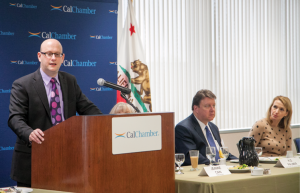![]() Governor Edmund G. Brown Jr, this week proposed a prudent and balanced state budget for 2017–18 that eliminates a projected $2 billion deficit and bolsters the state’s Rainy Day Fund, while continuing to invest in core programs.
Governor Edmund G. Brown Jr, this week proposed a prudent and balanced state budget for 2017–18 that eliminates a projected $2 billion deficit and bolsters the state’s Rainy Day Fund, while continuing to invest in core programs.
“In the midst of economic and policy uncertainty, Governor Brown’s prudent budget proposal is a smart approach that will protect taxpayers and important state programs for the long run,” said California Chamber of Commerce President and CEO Allan Zaremberg.
In a letter to the Legislature, the Governor commented, “In all likelihood, the coming years will bring even worse financial news—either from the start of the next inevitable recession or from changes at the federal level. This uncertainty about the future makes acting responsibly now even more important.”

Budget Highlights
According to the Governor’s news release, significant details of the Governor’s 2017–18 State Budget include:
• Keeping Budget Balanced
The budget proposes $3.2 billion in solutions to ensure a balanced budget. By tempering spending growth rather than cutting existing program levels, these actions minimize the negative effects on Californians.
The solutions include adjusting Proposition 98 spending, recapturing unspent allocations from 2016 and constraining some projected spending growth. In total, General Fund spending remains flat compared to 2016–17.
• Bolstering State Reserves
Proposition 2 establishes a constitutional goal of having 10% of tax revenues in the state’s Rainy Day Fund. With a $1.15 billion deposit in the budget, the Rainy Day Fund will total $7.9 billion by the end of 2017–18, 63% of the constitutional target.
Although a full Rainy Day Fund might not eliminate the need for further spending reductions in case of a recession or major federal policy changes, saving now would allow the state to soften the magnitude and length of necessary cuts.
• Increasing Education Funding
K–14 funding is expected to grow to $73.5 billion in 2017–18, up 55% ($26.2 billion) from 2011–12. For K–12 schools, funding levels will increase by about $3,900 per student in 2017–18 over 2011–12 levels. This reinvestment provides the opportunity to correct historical inequities in school district funding with continued implementation of the Local Control Funding Formula.
• Continuing Health Care Expansion
Under the optional expansion provisions of the federal Affordable Care Act, the budget increases enrollment of this Medi-Cal population to 4.1 million Californians, with the state’s General Fund share of cost increasing from $888 million to nearly $1.6 billion.
• Counteracting Poverty
California has an extensive safety net for the state’s residents who live in poverty. Since 2012, the General Fund has invested about $18 billion annually to help those in poverty.
The budget continues to fund several programs, including the Earned Income Tax Credit and a cost-of-living adjustment for recipients of supplemental income payments.
• Strengthening Transportation Infrastructure
Annual maintenance and repairs of California’s highways, roads and bridges are billions of dollars more than can be funded annually within existing revenues.
The budget reflects the Governor’s transportation package, first proposed in September 2015, which would provide $4.2 billion annually to improve the maintenance of highways and local roads, expand public transit and strengthen critical trade routes.
• Climate Change
The state has appropriated $3.4 billion in cap-and-trade auction proceeds to help reduce greenhouse gas emissions, with funding prioritized in disadvantaged communities. With volatility in recent auctions due in part to uncertainty about the program’s post-2020 future, the administration proposes two-thirds urgency legislation to confirm the program’s continued authority beyond 2020.
Assuming approval, the budget proposes $2.2 billion in expenditures from auction proceeds, with a continued emphasis on low-income and disadvantaged communities.
Full Summary
The full summary of the Governor’s budget proposal is at www.ebudget.ca.gov.

